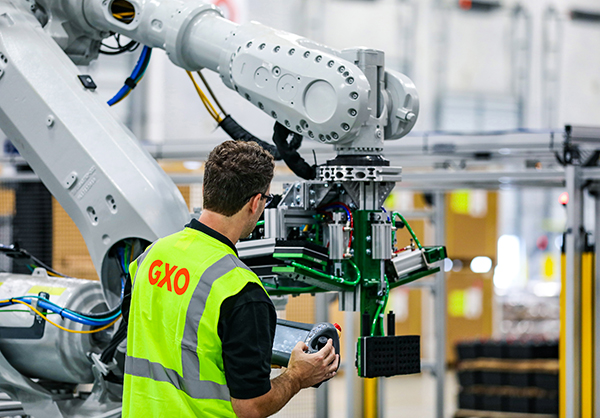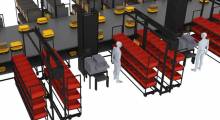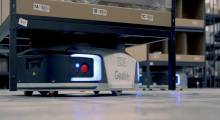About 95% of warehouses in North America and Europe are not yet automated, according to GXO Logistics Inc. The Greenwich, Conn.-based company recently announced its fourth-quarter earnings for 2021. It said its revenue increased from $2 billion in last year's third quarter to $2.3 billion in Q4, thanks in part to its increasing use of automation.
GXO, which claimed to be “the world's largest pure-play contract logistics provider,” cited the growth of automation, e-commerce, and outsourcing as “tailwinds” that it expects to continue into 2022. The company reported full-year revenue of $7.9 billion, up 28% over the year prior, as well as increases of 45% in e-commerce revenue and 28% in reverse-logistics revenue.
“We delivered to our customers an immensely successful peak,” said Neil Shelton, chief strategy officer at GXO Logistics. “We saw an acceleration in our business: From mid-November until just before Christmas, e-commerce levels doubled from the start of the quarter. Using automation and our world-class talent, we were able to drive value to customers.”
E-commerce, returns drive GXO growth
“We over-indexed into e-commerce, which includes the most complex processes in any warehouse,” Shelton told Robotics 24/7. “It's a great opportunity to help existing and potential customers solve the channel shift.”
“We won contracts with an aggregate lifetime value of $5 billion, and our sales pipeline was up $45 million in 2021,” he said. “We already have more than $830 million in contracts for 2022.”
“We see substantial growth oportunities throughout the warehouse, especially for high-velocity goods like food and beverage and e-commerce,” added Phil Shaw, Europe divisional operations director at GXO. “We're retrieving several hundred-thousand items from stockholding, which need to get to the packer at the same time.”
In particular, returns are an increasingly significant portion of e-commerce. “We'll see further acceleration in returns, which always lag e-commerce activity,” said Shelton. “The less excess stock to discount at the end of season, the better for gross margins.”
The third-party logistics (3PL) market is competitive and fragmented, but Shelton said automation gives GXO a “head start” in serving major e-commerce customers. This includes non-retail industries including aerospace and electronics manufacturing, and even telecommunications providers such as BT Group that need to deploy fiber in the right place, he said.
“I was at an e-commerce site in Europe that was using cobots for the first time on the mezzanine floor,” recalled Shelton. “Since we took over at that facility, the setup drove 45% improvement in next-day delivery of products, and it processed returns within 48 hours.”
Modular technology improves productivity
GXO Logistics uses collaborative robots and autonomous mobile robots (AMRs) to quickly fulfill orders and process returns. The company said it can double productivity rates and improve accuracy by up to 50%.
For instance, GXO recently piloted KNAPP AG's Pick-it-Easy station for automated pocket induction of apparel. It also deployed Chuck AMRs from 6 River Systems Inc. at a multilevel distribution center in the U.K., reducing new employee training time by 80%.
“We're continuing to deploy technology—especially modular technology—to handle peak,” Shelton said. “This includes goods-to-person automation, AMRs, and cobots, which work with our talent.”
“One of the more exciting areas for deploying technology are pocket sorters,” Shelton added. “We can bring down the high cost of returns substantially by using vision technology and deploying machine learning so that the process of grading is increasingly thorough.”
How much does GXO customize supply chain technologies for its customers?
“We take best-in-class robots for picking and packing, with our warehouse management system [WMS] and data, for a holistic solution,” Shelton replied.
“All our solutions are totally bespoke. We design unique solutions based on customer needs for the next five to 10 years,” added Shaw. “Putaway and retrieval systems must accomodate huge fluctuations in stockholding. We use automated storage and retrieval systems [ASRS], which are particularly effective in Europe, where the real estate costs more than in the U.S. We then link high-density storage to goods-to-person automation.”
“In grocery, the difference is the short shelf life and chilled products,” he said. “You have to have efficient processes to see what's in stock and to dispatch to retail stores or e-commerce routes. We see many and varied opportunities to apply velocity.”
GXO scales to overcome labor shortages
As retailers struggle with worker shortages and the need for technical expertise, many have turned to outsourcing and automation. GXO said its scale allows its customers to maximize the benefits of services and automation.
“If you're a large U.S. company, you might have three warehouses in the U.S., but we have 300,” Shelton said. “Our information on how to resource in terms of pay or benefits is vastly different from any company in the U.S. or Europe.”
“We're also more automated within our industry,” said Shelton. “We're piloting 200 pieces of technology, including robots and grippers, from different vendors, which you couldn't do if you had just two warehouses. People enjoy working with our technology, which is not only safer, but it creates empowerment, which drives higher productivity.”
While the COVID-19 pandemic has accelerated e-commerce demand, GXO has been using robots in logistics for some time.
“We were using robotics way before the pandemic,” Shaw noted. “We've reduced human touch points. Where handheld scanners were traditionally used, we're now using Cognex cameras. Returns are primarily a qualitative process for sortation, and vision technology is key.”
GXO last year opened nine automated sites in the U.S. and three in Europe in 2021, and it plans more for this year.
“We have hundreds of people in our human resources team, and we added 20,000 people in the fourth quarter,” Shelton said. “There are a lot of problems for us to solve.”
About the Author
Follow Robotics 24/7 on Linkedin
Article topics
Email Sign Up

















